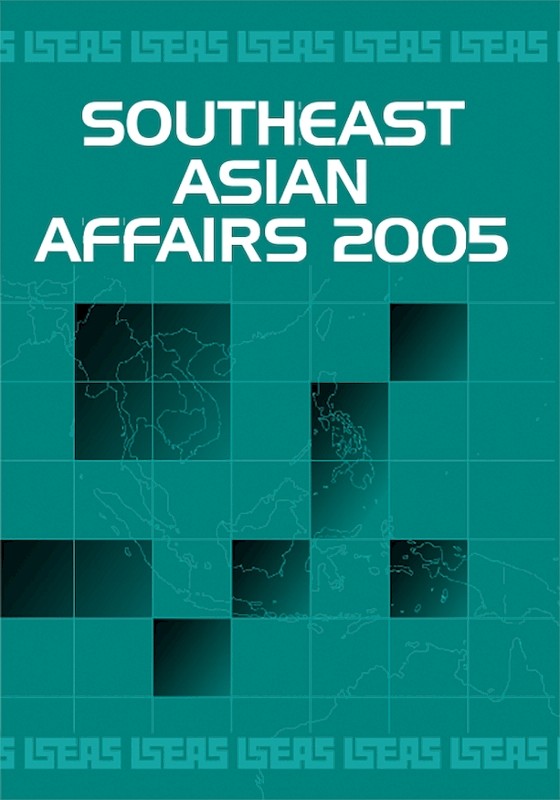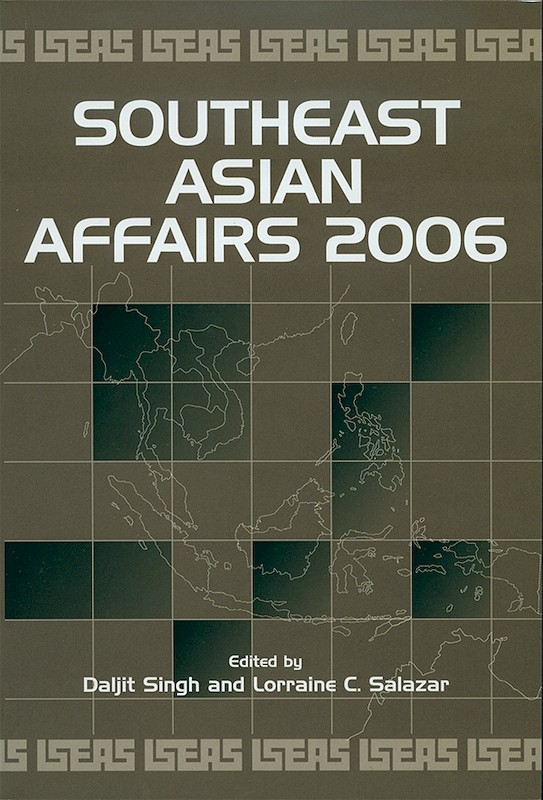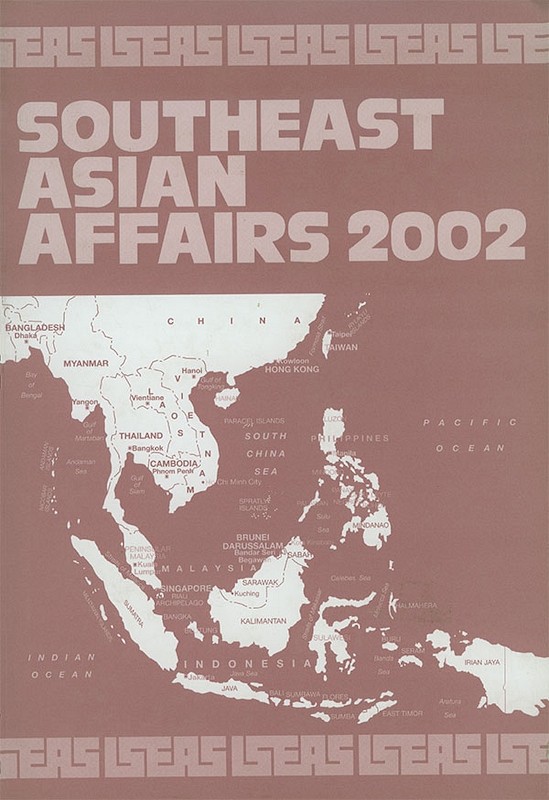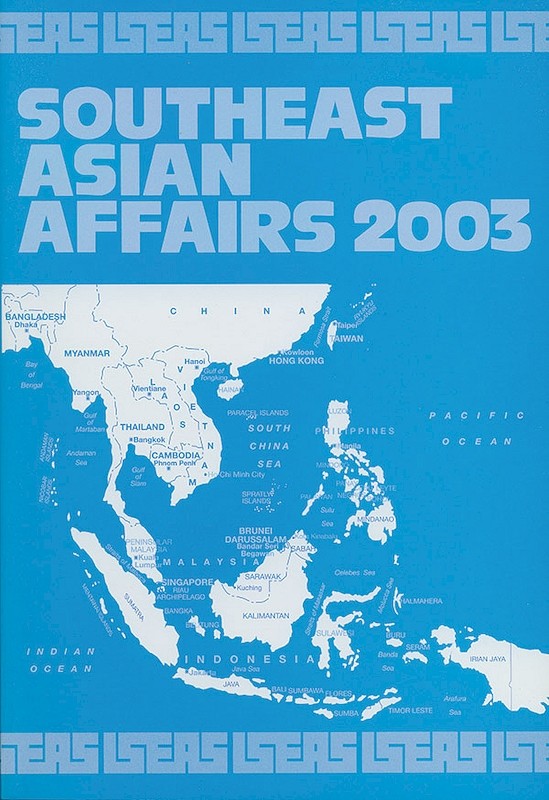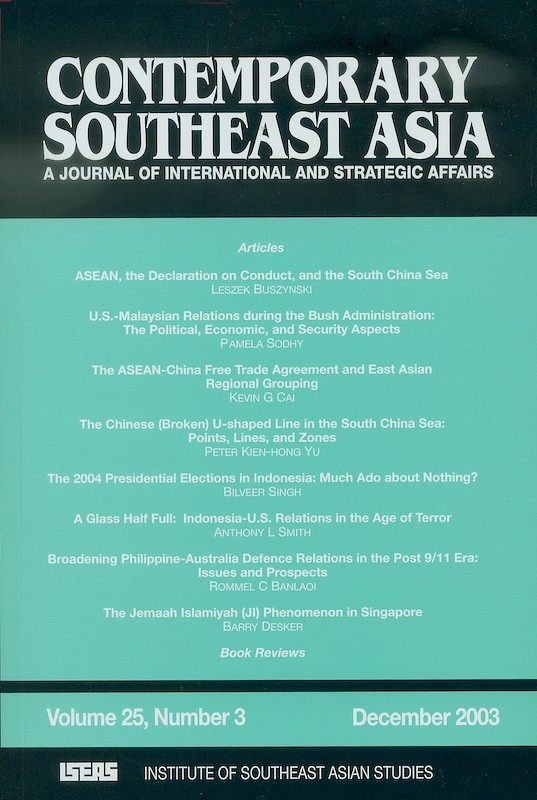Southeast Asian Affairs 2004

Date of publication:
2004
Number of pages:
312
Code:
SEAA4
About the publication
Southeast Asian Affairs, of which there are now thirty-one in the series, is an annual review of significant developments and trends in the region. Though the emphasis is on ASEAN countries, developments in the broader Asia-Pacific region are not ignored. Readable and easily understood analyses are offered of major political, economic, social, and strategic developments within Southeast Asia.
The contributions can be divided into two broad categories. There are those which provide an analysis of major developments during 2003 in individual Southeast Asian countries and in the region generally. Then there are the theme articles of a more specialized nature which deal with topical problems of concern.
The volume contains twenty articles dealing with such major themes as international conflict and co-operation, political stability, and economic growth and development.
The contributions can be divided into two broad categories. There are those which provide an analysis of major developments during 2003 in individual Southeast Asian countries and in the region generally. Then there are the theme articles of a more specialized nature which deal with topical problems of concern.
The volume contains twenty articles dealing with such major themes as international conflict and co-operation, political stability, and economic growth and development.
Contents
-
Southeast Asian Affairs 2004
-
Preliminary pages
- THE REGION
-
ASEAN in 2003: Adversity and Response, by Richard Stubbs, author see abstractDuring the first few months of 2003 ASEAN faced considerable adversity. The threat of terrorism hung over the region, ASEAN members were divided over the war in Iraq, and individual security and the weakened regional economy was placed in jeopardy by the ourbreak of Severe Acute Respiratory Syndrome (SARS). However, by the end of the year ASEAN had responded to these challenges and even notched up a series of successes. An ASEAN summit with China contributed to bringing SARS under control; China, India and Japan signed the treaty of Amity and Cooperation; and ASEAN economies were aided by growing links to China and increased cooperation among the members of the ASEAN+3 grouping. ASEAN also agreed to the development of an ASEAN Community by 2020. Overall, despite some continuing problems such as the persistence of regional terrorism and Myanmar governments treatment of opposition leaders, ASEAN proved that it could provide concrete benefits to its members.
-
Southeast Asia's Economic Performance: Achievements and Challenges, by Anne Booth, author see abstractDespite gloomy prognoses at the end of 2002, the war in Iraq and the emergence from China of a life threatening influenza virus, 2003 has turned out to be a year of reasonable economic progress in most parts of the ASEAN region. Preliminary estimates of GDP growth by the Asian Development Bank (ADB) indicate that most countries have achieved faster growth in 2003 than in 2002. But any optimistic forecast for ASEAN economic performance in coming years must be tempered by a recognition that a number of economic indicators still give cause for concern. This survey examines the evidence on macroeconomic performance, including consumption and investment expenditures, export performance and fiscal and monetary policies. There is also an examination of unemployment trends since the crisis and the problem of providing productive employment for the millions of young people coming out of schools, colleges and universities across the ASEAN region. Finally the survey examines the most recent statistics on poverty in the ASEAN region, and ask how pro-poor growth can be achieved in those parts of the region where the incidence of poverty remains high.
-
Southeast Asia-China Relations: Dialectics of "Hedging" and "Counter-Hedging", by Chien-peng (C.P.) Chung, author see abstractIn recent years, Southeast Asian countries have adopted a form of fence-straddling or hedging behaviour of combining economic engagement with strategic hesitation when it comes to dealing with China. Southeast Asian countries hope to optimize economic opportunities and benefits with China, but also help the United States retain a military presence in the region and engage Japan in non-traditional security roles. On its part, China wants to turn Southeast Asia's desire to hedge on China into a longing for comprehensive cooperation instead. In reaching out to the region, Beijing is prepared to adopt a strategy of counter-hedging, by broadening and intensifying existing modes of diplomatic, economic, security, or socio-cultural interaction between China and Southeast Asian countries, to make them come to terms with China's leadership in Asia.
-
Terrorism in Southeast Asia: The Ideological and Political Dimensions, by Kumar Ramakrishna, author see abstractThe reason why Islamist terrorism still threatens Southeast Asia despite the capture of senior terrorist leaders is the vitality of the underlying ideology animating jihadi networks such as Jemaah Islamiyah (JI). Due to the participation of senior JI leaders in the anti-Soviet jihad in Afghanistan, Saudi militant Osama bin Ladens vision of restoring a Global Islamic Caliphate stretching from North Africa to Southeast Asia, has since the early 1990s, overlaid JIs original Indonesia-centric aspirations. In addition, JI leaders have legitimized their ideological arguments by deliberately exploiting real and/or perceived Muslim grievances in Southeast Asia and even beyond. Hence in combating JI and the wider threat of radical Islamist terrorism, it is critical not to be over-fixated with a primarily military and law enforcement approach. Creative ways are needed to combat the virulent ideology that animates JI and reduce systematically the political oxygen that sustains it.
- BRUNEI DARUSSALAM
-
Brunei Darussalam: Steady Ahead, by Hj Mohd Yusop Hj Damit, author see abstractThis article summarises some of the main events in Brunei in 2003. It is divided into three sections: economic development, socio-politics and foreign relations. The year witnessed earnest efforts by the government to diversify the economy away from the oil and gas. And so were studies to attract foreign direct investment and feasibility of development of different projects including establishing downstream and manufacturing industries and developing a mega port. In the socio-political front the country continued to enjoy the proverbial peace with little disturbances. Much attention on the part of the whole country focused in the preparation for the grand celebration for the twentieth anniversary of the national day to be held on 23 February 2004. Disputes over the oil-rich waters in the South China Sea with Malaysia remained the nagging issue in Bruneis foreign relations. Both countries tried to find a peaceful solution to the problem but by the end of the year there seemed able only to halt any drilling activities in the area. This article summarises some of the main events in Brunei in 2003. It is divided into three sections: economic development, socio-politics and foreign relations. The year witnessed earnest efforts by the government to diversify the economy away from the oil and gas. And so were studies to attract foreign direct investment and feasibility of development of different projects including establishing downstream and manufacturing industries and developing a mega port. In the socio-political front the country continued to enjoy the proverbial peace with little disturbances. Much attention on the part of the whole country focused in the preparation for the grand celebration for the twentieth anniversary of the national day to be held on 23 February 2004. Disputes over the oil-rich waters in the South China Sea with Malaysia remained the nagging issue in Bruneis foreign relations. Both countries tried to find a peaceful solution to the problem but by the end of the year there seemed able only to halt any drilling activities in the area.
- CAMBODIA
-
Cambodia: Strongman, Terrible Man, Invisible Man, and Politics of Power Sharing, by Tin Maung Maung Than, author see abstractThe year 2003 turned out reasonably well for Cambodias economy despite the disruptions, in the first quarter, caused by the SARS scare and the anti-Thai riots. However, in the political arena, it was a disappointing year, to say the least, with the general elections failing to produce a stable government. The results of the ballot were not accepted by those who lost the election. The incumbent prime minister Hun Sen (the strongman), the opposition leader Sam Rainsy (the terrible man) and the National Assembly president Prince Ranariddh (the invisible man) could not agree upon a satisfactory power sharing formula with the latter two joining up to deny the former of the countrys premiership despite a convincing victory by Hun Sens Cambodian Peoples Party (CPP) in the July elections. The outcome was the dissolution of the ruling coalition, a hung (suspended) parliament and an uncertain political climate that prevailed throughout the second half of the year.
- INDONESIA
-
Indonesia: Continuing Challenges and Fragile Stability, by Leo Suryadinata, author see abstractIndonesia under President Megawati Sukarnoputri became the target of terrorist attacks but remained relatively stable despite these attacks. Separatist movements and sectarian tension, if not conflict, continued. The economic situation improved somewhat and it graduated from the IMF tutelage programme. In foreign policy, Jakarta remained active, attempting to play a major role despite its internal problems. Indonesia in 2003 was busy preparing the 2004 elections. The process and results of the forthcoming elections are important as they will indicate whether Indonesia will still be stable in the next five years.
-
Islamic Radicalism in Indonesia: The Faltering Revival?, by Greg Fealy, author see abstractThe emergence of radical Islamic groups in Indonesia has been one of the distinguishing features of the post-Soeharto era reformasi. These have included the terrorist Jemaah Islamiyah, paramilitary groups such as Laskar Jihad, and the vigilante Front Pembela Islam. Greg Fealy examines six of the main radical groups and considers their ideology, intellectual sources, organisational structure as well as leadership and membership. Particular attention is given to their attitudes to the state, Islamic law, the West and democracy. Fealy argues that, despite their rapid growth from 1998 to 2002, radical groups have suffered a number of serious setbacks in the past 18 months and that Islamic radicalism in general is in decline, at least for the time being. Hardening attitudes from the security services, public repugnance at terrorist attacks within Indonesia, and a reassertion of moderate Islamic values by mainstream groups have created a far less conducive environment for Muslim radicals.
- LAOS
-
Laos: Exiguous Evidence of Economic Reform and Development, by Nick J Freeman, author see abstractThere were relatively few surprising or significant developments in Laos during 2003, although various events served to underline the rather unique character and specific challenges that confront one of Southeast Asias least developed countries. These included: some changes in the government line-up, and revisions to the national constitution; an increase in banditry and bombing incidents; new efforts to streamline the business environment; on-going efforts to reform the state sector; preparations to assume chairmanship of ASEAN in 2004; a debt agreement with Russia; twists and turns in the energy sector; and new initiatives in the mining sector. Looking ahead, the prospects for Laos immediate future depend on the extent to which economic reform and business liberalisation policies can be designed, introduced and implemented successfully. But there is no indication that the incremental approach adopted by the leadership towards economic reform will either be markedly accelerated or decelerated in the near term.
- MALAYSIA
-
Tears and Fears: Tun Mahathirs Last Hurrah, by Bridget Welsh, author see abstractMalaysia fourth and longest serving Prime Minister stepped down in October after a sixteen-month leadership transition. This article examines Tun Mahathir's last year in office and the steps taken by his successor Abdullah Ahmad Badawi to correct the warts of the Mahathir years and distance himself from the man who put him in office. Mahathir's exit, like his twenty-two year tenure, was controversial. His "last hurrah" was in keeping with his combative and personal style that had made Malaysia synonymous with his persona. Abdullah Ahmad Badawi has cautiously set his own path and has launched a series of populist initiatives to earn his own mandate. His reforms point to the emergence of a new social contract between the state and Malaysians, yet these reforms are likely to be severely hampered by the shortcomings of the Mahathir era.
-
Sabah and Sarawak: The More Things Change the More They Remain the Same, by James Chin, author see abstractIn Sabah the return of Parti Bersatu Sabah (PBS) saw a realignment of Kadazan-Dusun politics within the ruling Sabah Barisan Nasional. The addition of twelve new constituencies and boundary changes meant that Muslim voters are now the determinants of future electoral outcomes. In Sarawak, infighting among the Dayaks saw the destruction of Sarawak National Party (SNAP) and Parti Bansa Dayak Sarawak (PBDS), leading to the birth of two new parties. The second half of the year witnessed preparations for the general election. At years end, the feeling was that little had changed fundamentally in the body politic of both states. The non-Muslim indigenes of both states despite their constituting the largest ethnic group - are kept out of power by the Muslims. The Chinese remain the second most powerful group, a position they had held for many years and a position they are comfortable with. As they say, the more things change, the more they remain the same.
- MYANMAR
-
Myanmar: Roadmap to Where?, by Robert H. Taylor, author see abstractAt the end of 2003 it appeared that the army government of Myanmar, the State Peace and Development Council, was finally contemplating creating a constitutional future for the country. After nearly 16 years in power, it had begun to create a coalition of the willing amongst the countrys many minority groups and some political parties looking to hold a constitutional convention in 2004. However, what role, if any Daw Aung San Suu Kyi and her National League for Democracy would have in a constitutional process remained unclear. This followed a major deterioration in relations between the NLD and the government resulting in an attack on NLD supporters in May. Myanmar remained isolated from the West but its active diplomacy ensured improved relations with India, China and Thailand. However, the economy remained weak as a consequence of the application of further Western economic sanctions and a domestic banking crisis which disrupted capital intensive businesses early in the year.
- THE PHILIPPINES
-
The Philippines: Playing Out Long Conflicts, by Paul A Rodell, author see abstractThe year 2003 saw the continued playing out of long-standing conflicts in the Philippines. Some of these conflicts, such as the Muslim separatism in Mindanao and the decades old insurgency of the Communist Party of the Philippines, included armed combat. Just as contentious, however, were those conflicts over political power and influence that saw familiar actors contesting for advantage over their rivals. Some of the conflicts were out in the open, such as Senator Panfilo Lacsons attacks on the presidents husband. Other conflicts, with origins in the Marcos era, were conducted surreptitiously via a failed military coup and a thwarted impeachment of the Chief Justice of the Supreme Court. By years end, new sets of temporary allies had coalesced into makeshift political alliances to contest the 2004 elections that feature the reelectionist woman president squaring off against the latest film star turned politician.
-
The GRP-MILF Peace Talks: Quo Vadis?, by Rizal Buendia, author see abstractThe article examines the tenuous peace talks between the Government of the Philippines (GRP) and the Moro Islamic Liberation Front (MILF). It analyses the reasons for the continuing secessionist movement despite of the enactment of the Muslim autonomy law and creation of the regional autonomous government. The state has not only failed to deliver substantive autonomy to the Muslims but also responded inadequately to the causes of self-determination rebellion. The limitation of states governmental system and MILFs inability to gain popular support for its secessionist struggle have left the parties no other recourse but to settle the conflict through protracted peace negotiations. Uncertainty looms as the 2004 Presidential elections draw near as a possible change in political leadership may further delay the conclusion of a final peace agreement between the GRP and MILF.
- SINGAPORE
-
Singapore: Surviving the Downside of Globalization, by Asad-ul Iqbal Latif, author see abstractAn open economy has underwritten Singapore's remarkable economic transformation in the past three decades. Globalisation continues to be the city-state's lifeline to the world. In 2003, however, the downside of globalisation appeared in the form of the Severe Acute Resporatory Syndrome (SARS), the Iraq War and the continuing threat of terrorism. These problems affected Singapore's economy and underscored the problems which a small country with an open economy faces when confronted by international events over which it has little control. Singapore responded to the threats by combining a determination to take hard economic decisions with a finely-hone efficiency in its social organisation. By year-end, the country's prospects were looking up. Asad Latif, a Senior Writer at The Straits Times in Singapore, examines what happened during a momentous year.
-
Singapores Bilateral Trading Arrangements in the Context of East Asian Regionalism: State of Play, Issues, and Prospects, by Linda Low, author see abstractA review of the multilateral training system and WTO in particular shows economic and political tensions emerging, degenerating into a kind of north-south divide among some 148 member states. The politics of trade liberalization is getting more troublesome and sadly, with the WTO as a victim of its own success in terms of expanded membership. As such a new regionalism has new purpose if not legitimacy, though it may well be argued that it is actually a cause of the WTO failure at Cancun. East Asian regionalism is rising to the occasion and challenge. But with the dynamics of abnormal economies like Japan, China and the U.S. impacting the region, the rules of the game are unlike anything in the past. Singapores fast and furious pace in bilateral free trade agreements also analyzed in these global and regional contexts. While the jury is out for all trade modalities, the issue of how to get countries together is a real and challenging one. Ultimately, the means must justify the end, i.e. free trade, however defined.
- THAILAND
-
Thailand: Politicized Thaksinization, by Chookiat Panaspornprasit, author see abstractThailand in 2003 remained under the custody of the Thaksin administration, which has the long-term political plan to be in power for the next twenty years. The ways in which Thaksin exercises the custodianship include the various political and economic mega-initiatives, both at home and abroad. Notwithstanding the criticisms leveled against the drawbacks of these mega projects, Thaksin confidently presses ahead with them with the expected end-results in mind. The emerging image of Thaksin as the visionary leader in Southeast Asia is still in dispute.
-
Thailand: International Terrorism and the Muslim South, by Kavi Chongkittavorn, author see abstractThailand is a new comer in the war against international terrorism. Before the September 11 attacks, the Thai government had never admitted it was a safe haven for international and regional terrorists. After the Bali bombing and arrests of several suspects, including Hambali, belonging to Jemaah Islamiah inside Thailand, the government wants to come clean and has since then been cooperating with the US and neighbouring countries on the terrorism threat. The new stance has far-reaching implications for the Muslim-dominated southern provinces. The estimated six million Thai-Muslims are highly suspicious of the government's anti-terrorism policies, which they believe is aimed at them. Violence in the south, which used to be manageable, has become widespread following the dispatch of Thai troops to Iraq. Now, the government has to cope with a new dilemma related to radical elements in the Thai-Muslim community and their linkages to terrorist groups overseas.
- TIMOR LESTE
-
Timor Leste: Strong Government, Weak State, by Anthony L Smith, author see abstractTimor Leste in 2003 was marked by the consolidation of power by the ruling party, while at the same time concerns over external and internal threats to stability remain. The government benches remain in the hands of the Fretilin Party, which openly boasts that it will be in power for the foreseeable future. This total dominance of the political executive has frustrated the main opposition parties, who routinely accuse the government of authoritarianism . While a robust opposition exists, it remains fractured. Pro-Indonesian militia elements still present an irritant to the border security of Timor Leste, but a stability threat from within Timor Leste has caused a great deal of concern, namely the difficulties from ex-Falintil guerilla fighters who missed out on the rewards of post-independence government employment.
- VIETNAM
-
Vietnam: Facing the Challenge of Integration, by Nguyen Manh Hung, author see abstractThis article presents a review of major developments in the Socialist Republic of Vietnam in 2003. It assesses the efforts of the Vietnamese authorities to combat corruption, reform the economy, and join the World Trade Organization in 2005. Obstacles to rapid economic growth and economic integration are identified. The governments treatment of religious and political dissidents and its response to international criticism are also examined. The chapter analyzes Vietnams defense strategy in the new stages of development, its diplomatic activities aimed at maintaining an international environment favorable to national reconstruction and defense, and a number of important steps taken by Vietnam to build a framework for a stable and long-term partnership with the United States.

